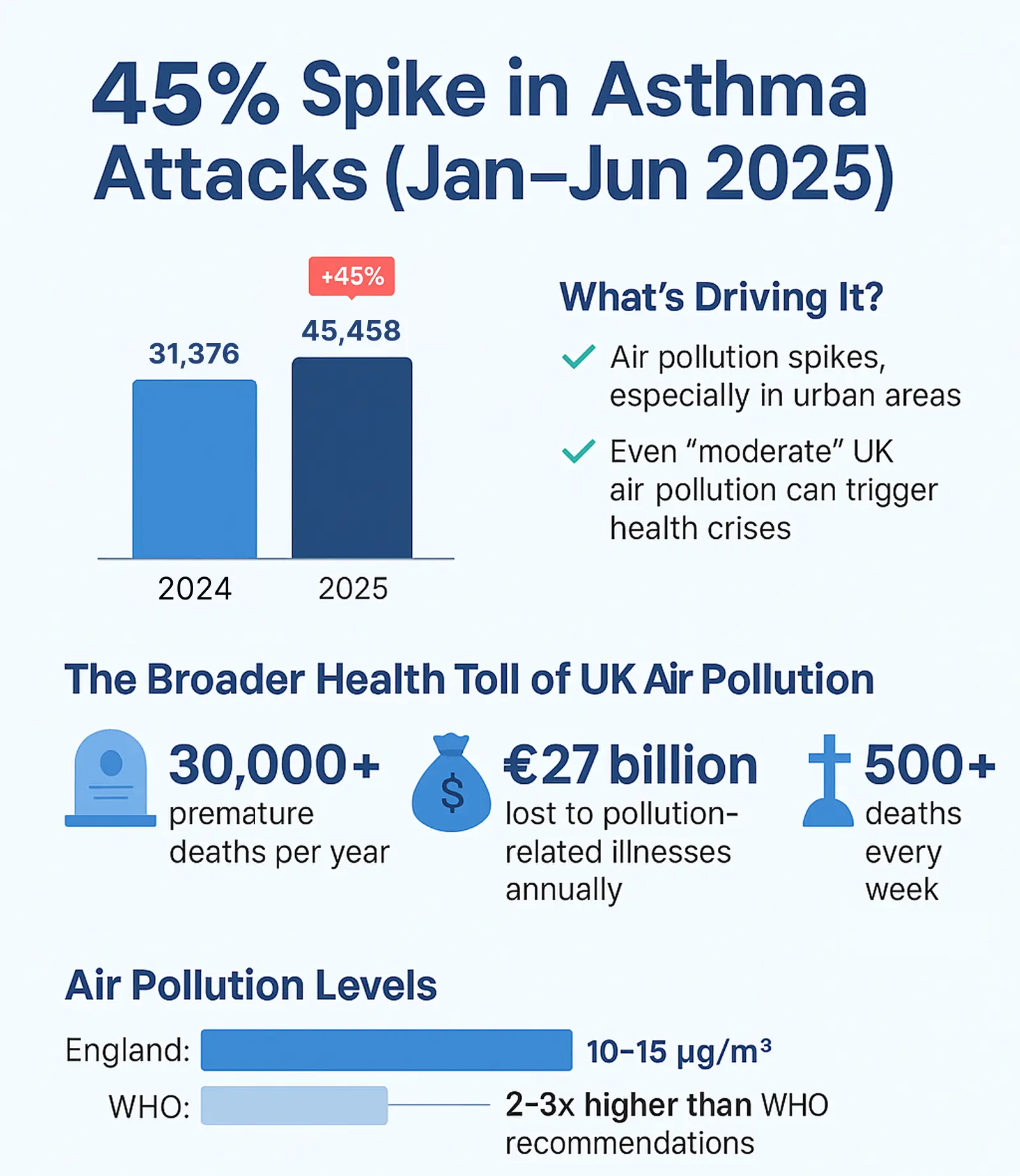In the first half of 2025, England witnessed a 45% surge in GP appointments for asthma attacks, with over 45,000 patients seeking treatment for breathing difficulties linked to deteriorating air quality. This sharp rise, reported by NHS England, has stunned a country where pollution levels are typically considered moderate by global standards. But it also raises a deeper question: if a developed nation with relatively cleaner air can experience such a spike in respiratory illness, what does this say about countries like India, where poor air quality is both chronic and mostly in “Poor to Hazardous” levels in many cities? Thus, here is the air pollution comparison between England vs India.
The contrast between these two countries as one deals with episodic air pollution events. On the other hand, another battle against a relentless pollution crisis provides critical insight into how air quality affects health outcomes across different socio-economic and environmental contexts. This blog offers a data-driven comparison of air pollution in England and India, examining health impacts, life expectancy, policy responses, and the urgent need for global attention to clean air as a public health priority.
England: Moderate Pollution, Sharp Health Impacts
Between January and June 2025, 45,458 people in England sought GP care due to asthma attacks, up from 31,376 during the same time frame in 2024. That’s a 45% year-over-year increase. Health authorities have attributed this rise to spikes in air pollution levels across multiple regions, particularly in urban areas.

Despite having air quality levels that often remain within moderate limits by international standards, the UK still records:
- Over 30,000 premature deaths per year due to air pollution
- An estimated £27 billion annual cost to the economy due to pollution-related illness
- An average reduction of 1.8 years in life expectancy per person
- Over 500 deaths every week are attributable to toxic air
Air pollution in England typically ranges from 10 to 15 micrograms per cubic meter (µg/m³) of PM2.5, which is about 2 to 3 times higher than the World Health Organization’s recommended guideline of 5 µg/m³.
This recent spike in asthma cases emphasizes a critical point: even relatively lower levels of air pollution can trigger serious health issues, especially among vulnerable populations such as children, the elderly, and people with pre-existing conditions.
India: High Pollution, Chronic Crisis
In contrast to England, India experiences some of the highest and most persistent air pollution levels in the world. The average annual PM2.5 concentration in many Indian cities is between 100+ µg/m³—10 to 20 times higher than the WHO guidelines.
Major statistics for India include:
- An estimated 670,000 deaths per year due to outdoor air pollution
- Air pollution contributes to around 18% of the total disease burden in India
- Delhi’s annual average PM2.5 level is typically around or above 95µg/m³
- In winter, AQI levels frequently cross 200–300, categorised as “Severe” or “Hazardous”
- Life expectancy in highly polluted regions is reduced by up to 10 years
India: The annual average PM2.5 for India in 2024 recorded 48 µg/m³, as per AQI.in. This figure indicates a significant exceedance of the WHO guideline (5 µg/m³), being 9.6 times higher, underscoring India’s chronic air pollution issue. The report also notes that only 10 cities in India achieved a ‘Good’ AQI annual average, with 92 of the top 100 most polluted cities globally located in India, supporting the high average.
Delhi, India: For Delhi, the user reports an annual average PM2.5 of 95 µg/m³ in 2024, 19 times the WHO guideline. This aligns with the report’s ranking of Delhi as the world’s most polluted capital city, with real-time data on July 1, 2025, showing 33 µg/m³ AQI.IN New Delhi, suggesting seasonal variations but confirming high annual levels.
Comparative Analysis: Air Pollution Comparison Between England vs India
| Metric | England (2025) | India (2024) |
| Asthma-related GP visits | 45,458 (Jan–Jun 2025) | Not reported nationally |
| Average PM2.5 | 10–15 µg/m³ | 48+ µg/m³ |
| WHO PM2.5 Limit | 5 µg/m³ | 5 µg/m³ |
| Exceedance of WHO Guidelines | 2–3 times | 9-10 times |
| Premature Deaths (Annual) | ~30,000 | ~670,000 |
| Life Expectancy Impact | −1.8 years | −10 years (in worst affected regions) |
| Peak AQI Levels | Often Moderate to Unhealthy | Regularly Severe to Hazardous |
This comparison illustrates a sobering truth: chronic exposure to high pollution in India leads to systemic health degradation, while even temporary pollution spikes in England trigger acute health events like asthma attacks.
What This Means
Air quality is often viewed as an environmental issue, but it is fundamentally a public health emergency. Both England and India offer valuable insights:

- In England, air that would be considered “relatively clean” by Indian standards is still dangerous enough to cause a surge in asthma attacks.
- In India, populations live under a constant cloud of pollution that reduces lifespans, lowers lung function, and increases rates of cancer, heart disease, and respiratory illness.
Moreover, both countries demonstrate the disproportionate impact of air pollution on disadvantaged groups. In England, ethnic minorities and residents of deprived neighbourhoods are more likely to suffer from pollution-related illnesses. In India, low-income groups often live closest to major roads or industrial zones and have limited access to healthcare.
Policy Implications
The situation in England reinforces the urgency of maintaining strict air quality controls even in countries with relatively lower pollution. Meanwhile, India’s crisis highlights the consequences of delayed or insufficient regulation, weak enforcement, and urban planning failures.
What must change?
For England:
- Expand clean air zones and improve public transport.
- Accelerate the adoption of electric vehicles.
- Tighten indoor air quality regulations in homes and schools.
For India:
- Transition aggressively to renewable energy.
- Ban stubble burning through viable alternatives for farmers.
- Mandate stricter industrial and vehicular emission standards.
- Make air quality monitoring and health data publicly accessible.
Conclusion
Air pollution is not just about smog-filled skies or visibility; it’s a silent killer affecting millions every year. The 45% rise in asthma-related GP visits in England should be a wake-up call—not just for the UK, but globally. It shows how little it takes for even relatively clean air to become a health hazard. In India, where pollution is a daily reality, the health consequences are exponentially more severe and long-lasting.
The path forward requires urgent, science-based policymaking, international cooperation, and widespread public awareness. Clean air is not a luxury. It is a non-negotiable human right.